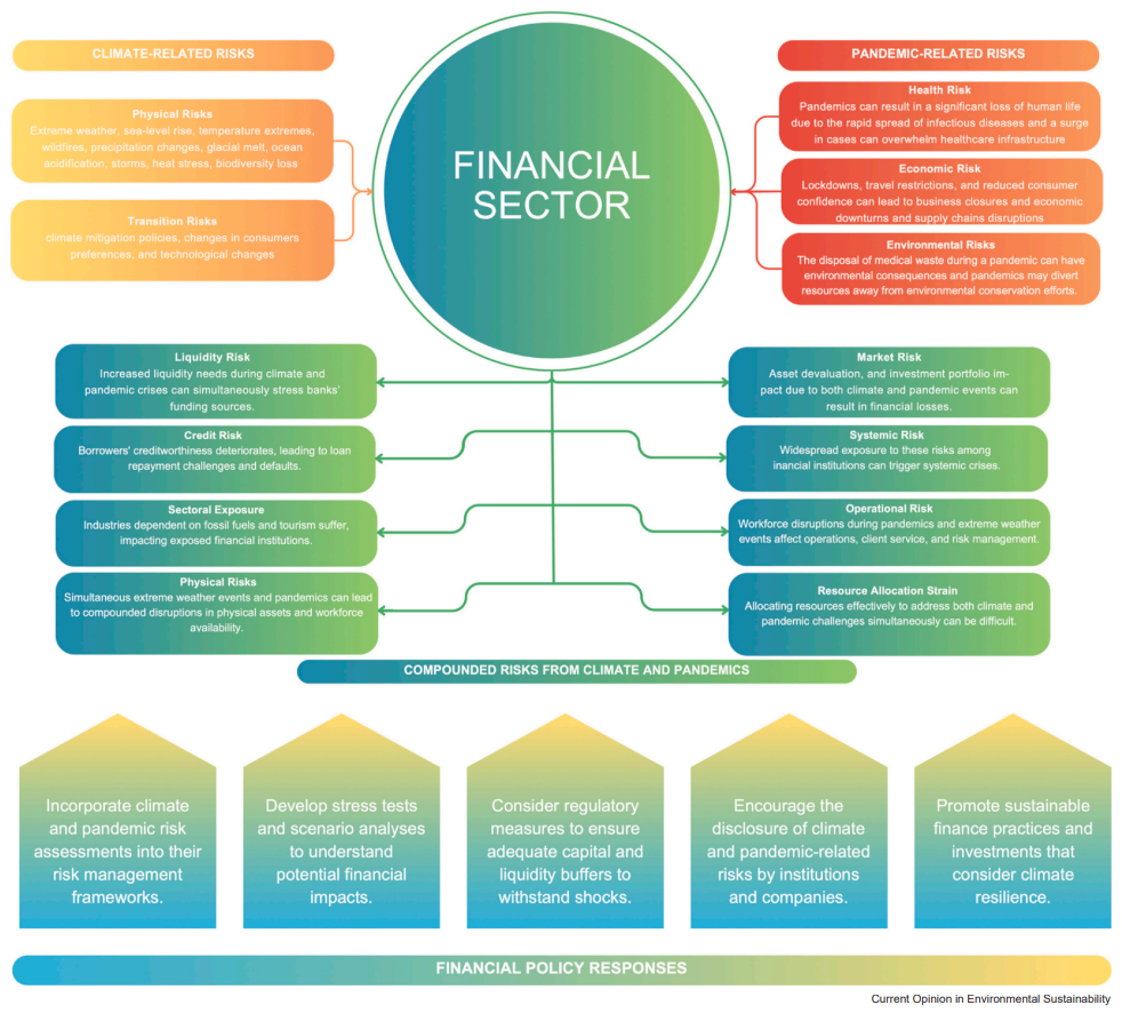References
Aristei, D. and M. Gallo (2023). Green management, access to credit, and firms’ vulnerability to the COVID-19 crisis. Small Business Economics, 1–33.
Berger, A. N., A. Demirgüç-Kunt, F. Moshirian, and A. Saunders (2021). The way forward for banks during the COVID-19 crisis and beyond: Government and central bank responses, threats to the global banking industry.
Bloom, D. E., M. Kuhn, and K. Prettner (2022). Modern infectious diseases: macroeconomic impacts and policy responses. Journal of Economic Literature 60 (1), 85–131.
Boneva, L., G. Ferrucci, and F. P. Mongelli (2022). Climate change and central banks: what role for monetary policy? Climate Policy, 1–18.
Borri, N. and G. Di Giorgio (2022). Systemic risk and the covid challenge in the european banking sector. Journal of Banking & Finance 140, 106073.
D’Orazio, P. (2021). Towards a post-pandemic policy framework to manage climate-related financial risks and resilience. Climate Policy 21(10), 1368–1382.
D’Orazio, P. (2022). Mapping the emergence and diffusion of climate-related financial policies: Evidence from a cluster analysis on G20 countries. International Economics 169, 135–147.
D’Orazio, P. (2023a). Are Current Prudential Frameworks Up to the Challenge of Climate Risks? Intereconomics 58(2), 96–101.
D’Orazio, P. (2023b). Climate change and macro-financial risks: financial policy responses for an orderly low-carbon transition. Environmental Research: Climate 2(1), 013002.
D’Orazio, P. (2023c). A global database for climate-related financial policies. BMC Research Notes 16(1), 1–7.
D’Orazio, P. (2023d). Navigating financial stability through the dual challenges of climate change and pandemics. Current Opinion in Environmental Sustainability, 65, 101386. https://doi.org/10.1016/j.cosust.2023.101386
D’Orazio, P. and L. Popoyan (2022). Realising central banks’ climate ambitions through financial stability mandates. Intereconomics 57(2), 103–111.
D’Orazio, P. and S. Thole (2022). Climate-related financial policy index: a composite index to compare the engagement in green financial policymaking at the global level. Ecological Indicators 141, 109065.
Elnahass, M., V. Q. Trinh, and T. Li (2021). Global banking stability in the shadow of Covid-19 outbreak. Journal of International Financial Markets, Institutions and Money 72, 101322.
Ferriani, F. (2023). Issuing bonds during the covid-19 pandemic: Was there an ESG premium? International Review of Financial Analysis 88, 102653.
Feyen, E., T. A. Gispert, T. Kliatskova, and D. S. Mare (2021). Financial sector policy response to COVID-19 in emerging markets and developing economies. Journal of Banking & Finance 133, 106184.
Gubareva, M. and Z. Umar (2023). Emerging market debt and the COVID-19 pandemic: a time–frequency analysis of spreads and total returns dynamics. International Journal of Finance & Economics 28(1), 112–126.
Hoffart, F. M., P. D’Orazio, and C. Kemfert (2022). Geopolitical and climate risks threaten financial stability and energy transitions. Energy 2004, 2965.
Karydas, C. and A. Xepapadeas (2022). Climate change financial risks: Implications for asset pricing and interest rates. Journal of Financial Stability 63, 101061.
Le Billon, P., P. Lujala, D. Singh, V. Culbert, and B. Kristoffersen (2021). Fossil fuels, climate change, and the covid-19 crisis: pathways for a just and green post-pandemic recovery. Climate Policy 21(10), 1347–1356.
Le Quang, G. and L. Scialom (2022). Better safe than sorry: Macroprudential policy, covid 19 and climate change. International Economics 172, 403–413.
McKibbin, W. and R. Fernando (2021). The global macroeconomic impacts of COVID-19: Seven scenarios. Asian Economic Papers 20(2), 1–30.
Mzoughi, H., A. Ben Amar, F. Belaid, and K. Guesmi (2022). The impact of COVID-19 pandemic on islamic and conventional financial markets: International empirical evidence. The Quarterly Review of Economics and Finance 85, 303–325.
Pagnottoni, P., A. Spelta, A. Flori, and F. Pammolli (2022). Climate change and financial stability: Natural disaster impacts on global stock markets. Physica A: Statistical Mechanics and Its Applications 599, 127514.
Qanas, J. and M. Sawyer (2023). ’independence’ of central banks and the political economy of monetary policy. Review of Political Economy, 1–16.
Rossi, S. (2022). The political benefits of ’unconventional’ monetary policies in times of crisis. Review of Political Economy, 1–13.
Walmsley, T., A. Rose, R. John, D. Wei, J. P. Hl´avka, J. Machado, and K. Byrd (2023). Macroeconomic consequences of the COVID-19 pandemic. Economic Modelling 120, 106147.
Wei, X. and L. Han (2021). The impact of COVID-19 pandemic on transmission of monetary policy to financial markets. International Review of Financial Analysis 74, 101705.




